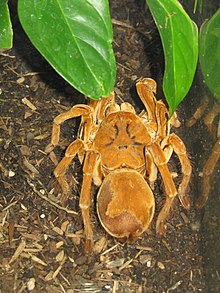Theraphosa blondi
| Theraphosa blondi | ||||||||||||
|---|---|---|---|---|---|---|---|---|---|---|---|---|

Theraphosa blondi female |
||||||||||||
| Systematics | ||||||||||||
|
||||||||||||
| Scientific name | ||||||||||||
| Theraphosa blondi | ||||||||||||
| ( Latreille , 1804) |

Theraphosa blondi (sometimes also called the giant tarantula or Goliath tarantula in German) isthe largest tarantula ever, with a body length of up to twelve centimeters and a leg span of up to 30 centimeters according to the Guinness Book of Records . It is very hairy and its color is rust to chestnut brown. Females can weigh up to 200 grams.
Adult males are less strongly built than females and are often darker in color. In contrast to many other species of tarantula, the males of the giant tarantula do not wear shin hooks (tibial apophyses) on their first pair of legs.
The giant tarantula's bite claws reach a length of approx. 2.5 centimeters. The abdomen can reach the size of a tennis ball if overfeeding in captivity . The hair on the abdomen is often incomplete, as the spider regularly lines its living tube with its stinging hair .
Occurrence and way of life
These animals live in the tropical rainforests of South America , in northern Brazil , in Suriname and in French Guiana . The humidity in their natural habitat is approx. 80 to 95% at a temperature of 25 to 32 ° C, whereby the microclimate in the buildings differs somewhat from the macroclimate.
The giant tarantula prefers moist areas. There she digs deep caves in the ground in order to have a sufficiently moist retreat in the dry season. It is one of the bombardier spiders that generate warning sounds, so-called stridulations , before the stinging hair is stripped off . When mating, the females are less aggressive than their general behavior suggests. A cocoon contains around 100 to 150 eggs. The young animals are already 1.5 to 2 cm tall when they hatch, which is roughly the size of an adult (female) garden spider .
Taxonomy
Pierre André Latreille described the art in 1804 in honor of its collector M. Le Blond as Mygale blondii and suggested "Mygale de Le Blond" as a common name . Since he also wrote it in italics, synonyms were subsequently created . From 1903 to 1996, the name Theraphosa leblondi was used frequently . Thorell placed the species in its own genus as early as 1870, which was monotypical until 2001 . The superfluous "i" in the ending of the species name was already omitted in 1874 by JT Moggridge. A very similar species from Guyana and Suriname, which used to be confused with Theraphosa blondi , is Theraphosa stirmi , which was only described in 2010 .
Toxicity
Some of the components of the Theraphosa blondi poison are peptides that affect the function of the potassium channels , TlTx1 , TlTx2 and TlTx3 .
Use by humans
Some South American indigenous people use Theraphosa blondi as a protein-rich food. Their taste should be similar to that of lobster or crab . In the terrarium hobby it is very popular because of its status as the largest spider in the world and its imposing appearance. There is currently an export ban from French Guiana for species of this genus, which has led to a significant rise in prices for offspring.
Web links
Theraphosa blondi in the World Spider Catalog
- Biotropics.com
- Theraphosa blondi Lots of supplements and additional information on the (giant tarantula) Theraphosa blondi
literature
- R.-P. Berno: Experiences with keeping and breeding Theraphosa blondi. In: DeArGe notifications. 6 (1), 2001, pp. 4-6.
- T. Deutschle: Impressions from the tropical lowland rainforest of French Guiana; Habitat of Theraphosa blondi (1). In: DeArGe notifications. 4 (5), 1999, pp. 3-7.
- T. Deutschle: Impressions from the tropical lowland rainforest of French Guiana; Habitat of Theraphosa blondi (2). In: DeArGe notifications. 4 (6), 1999, pp. 7-11.
- D. Eckhardt: Observations on the terrarium behavior of the tarantula Theraphosa leblondi LATREILLE 1804 (Theraphosinae). In: Arachnol. Number 5, 1990, pp. 11-14.
- R. Gabriel: Notes on the Husbandry and Captive Breeding of Theraphosa blondi. In: British Tarantula Society Journal. 18 (2), 2003, pp. 54-57.
- BS Gerschman de Pikelin, RD Schiapelli: Contribucion al conocimiento de Theraphosa leblondi (Latreille). 1804 (Araneae: Theraphosidae). In: Mem. Inst. Butantane. 33 (3), 1966, pp. 667-673.
- A. Köhler: Theraphosa blondi (Latreille, 1803) - a popular species of tarantula. In: Arthropoda. 7 (3), 1999, pp. 9-13.
- SD Marshall, GW Uetz: The growth and maturation of a giant spider: Theraphosa leblondi (Latreille, 1804) (Araneae, Theraphosidae). In: Revue Arachnologique. 10 (5), 1993, pp. 93-103.
- S. Munnery: Goliath bird eater Theraphosa blondi. In: Arachnida. 1 (1), 2001, pp. 15-22.
- P. Pastor: Bird spiders of the genus theraphosa. In: Sklípkan. 8 (4), 2003, pp. 130-133.
- B. Striffler, D. Weinmann: Tarantulas in Venezuela - from the Caribbean to the Tepuis. In: DRACO. 4 (16), 2003, pp. 70-76.
- RC West: Eating Bird-Eating Spiders. In: FAUNA. 1 (1), 1997, pp. 46-53.
- RC West: A fixed menu made from tarantulas. In: Reptilia. 2 (4), 1997, pp. 27-29.
Individual evidence
- ^ A b Jan-Peter Rudolff, Dirk Weinmann: A new gigant tarantula from Guyana. In: Arthropoda Scientia. 1 (1) 2010, publisher ZAG Wirbellose e. V., Dessau-Roßlau. ISSN 1866-5896
- ↑ J. Ebbinghaus, C. Legros, A. Nolting, C. Guette, ML Celerier, O. Pongs, R. Bähring: Modulation of Kv4.2 channels by a peptide isolated from the venom of the giant bird-eating tarantula Theraphosa leblondi . In: Toxicon. 43 (8), Jun 15, 2004, pp. 923-932. PMID 15208026